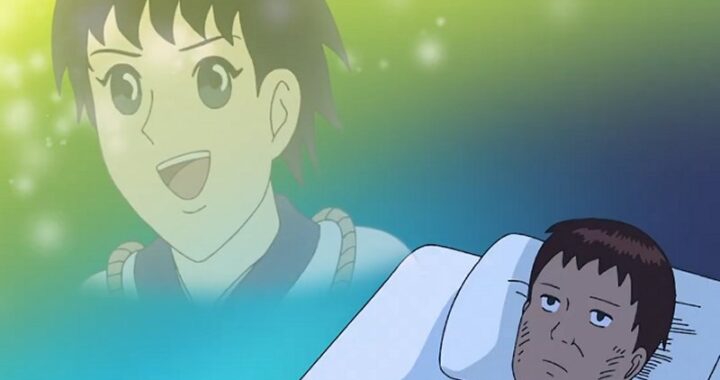 Galaxy Angel begins its third season, which is split into two parts, the first of which is Galaxy Angel A.
Galaxy Angel begins its third season, which is split into two parts, the first of which is Galaxy Angel A.
What They Say:
The Angel Brigade is no more! The five girls have all gone their separate ways, and if Volcott doesn’t reunite them, he’ll be out of a job! And that’s not the only problem – there’s a new team in town called the Galaxy Twin Stars, a pair of brothers who are perfect at everything, including finding Lost Technology. It’s a roller coaster of laughs, excitement and food as the dysfunctional Angel Brigade tries to pull themselves back together!
The Review:
Audio:
The audio presentation for this series brings us the original Japanese language track in stereo along with the previously created English language dub. The series is a fairly straightforward comedy piece that works a kind of full approach with its mix design as there’s not a lot in the way of directionality or other events. The show has a lot of dialogue to it and some big sound effects at times but there’s little in the way of placement or directionality as it wasn’t looking to work that angle. That said, the uncompressed encode here with the PCM design definitely helps to boost if over the old lossy mixes by a good degree as both tracks come across in a cleaner and bolder way while the music definitely makes out the best. The sound design won’t make this a must-upgrade aspect of the release but it’s definitely a welcome part of the puzzle.
Video:
Originally airing in 2002, the transfer for this TV series is presented in its original full frame aspect ratio encoded in 1080p using the AVC codec. Animated by Madhouse, the transfer here is a significant upgrade over the original as color definition is fantastic with the right kind of pop and vibrancy. A lot of it looks like it sits at various spots within the thirties in the bit rate and that really helps to push things forward in a great way. It’s a clean looking show that eliminates any of the noise and problems we had with the main show years ago and simply has a very solid look about it that’s like watching a different show. The character designs showcase more detail, the backgrounds have more that’s now visible with some of the darker areas, and overall it’s a strong upgrade. Some of the next episode preview pieces with its tight artwork showcase a bit of line noise but this is from the source material itself as opposed to the encode and is something we see from time to time from shows of this era.
Packaging:
The packaging design for this release brings us a standard sized Blu-ray case that holds the two discs against the interior walls. The front cover has a great image that focuses on the five girls together in their uniforms where it’s all very bright and vibrant with appealing designs that do, admittedly, feel like they come from a different age. The pink background gives it a little extra push as well that I like that complements the character colors. The logo along the bottom uses the familiar one and it blends well with the layout in general and just keeps the A to the side of it as almost a brand. The back cover gives us a couple more character images along the right and a few circle shots of pieces from the show itself along the left. That’s also where we get the basic summary of the premises along with some production credits and a good breakdown of the extras that are easy to read even with the smaller font. The technical grid along the bottom covers the rest. There are no inserts included with this release nor is there a reversible cover.
Menu:
The menu design for this release takes a step down from the clip-based ones we had before as it goes for a static visual of the characters. It works nicely enough because they’re colorful and have just enough detail but it’s a bit simpler overall. The colors stand out well and it’s definitely appealing with the visuals used. The navigation strip is one that works nicely with the logo along the left and a thin white strip along the right that has the selections in blue. It’s a standard design but it has the right tone to fit the show and it looks great during playback as a pop-up menu. My only frustration is that during playback you can’t tell what episode you’re on as it’s not highlighted when you go into the episodes submenu.
Extras:
The extras for this release are definitely fun to revisit once again with what we get. The pieces we like are here in the clean versions of the opening and closing sequences as well as a few clips of the Galaxy Angel Secret Live Concert series.
Content: (please note that content portions of a review may contain spoilers)
If there’s one thing that can be said about Galaxy Angel is that there is simply a lot of it. Counted as their original broadcast form, the first season had twenty-six episodes while the second season came in at just eighteen. The third season ran for fifty-two episodes and even after that a fourth season was underway. The third season which we have here was broken into two separate collections in Japan, the A Collection and AA collection. Obviously, we’ve got the A Collection here with the first twenty-six half-length episodes, which comes down to thirteen regular episodes across the two discs that we get here in high definition on Blu-ray for the first time. We’ve extolled the wonders of it in this format before as it looks great with its color design and it’s appealing to finally have so much of it in great quality.
This particular collection is a lot of fun and as much as I enjoyed the Z series, this one feels like it’s more true to the first season of the show with its humor and approach. It’s hard to define it sometimes wit ha comedy but the cast just feels sharper, the writing more spot on and filled with more cultural puns and language jokes as well as continuing the bizarre and freaky nature of the stories that simply seem like they couldn’t be connected with the series in general. That approach in fact is something that I like a lot about Galaxy Angel as it is reminiscent of a lot of older shows where the episode you’re watching is all you really need to know about and that’s all that counts. There isn’t a lot of connectedness to the series and it’s a real plus for this kind of writing and set of characters.
The season kicks off in an amusing way as the Angel Brigade has broken up (once again?) and everyone has gone their separate ways. Volcott is intent on getting everyone back together though and through his persistence and the way he’s easily manipulated, he’s able to get them working together again for a huge bump in pay and bonuses. The problem for the Brigade this time around, as they’ve always been considered a huge money drain on the taxpayer, is that a separate group was started up with two guys to handle dealing with the Lost Technology. And as expected, as much as they look just as fun as the Angel Brigade, they’re actually more capable in dealing with the Lost Technology and figuring it out without causing massive amounts of destruction first.
One example is when a particular planet finds itself dealing with an issue of giant black balls that are growing and replicating everywhere. The pair discovers that the best way to deal with them is to minimize the space they have to grow, so they just need to be moved into a contained space and closed in. The Angel Brigade gets their move in first though and they basically transport every building and creature off the planet and onto the moon, letting the black balls take over the planet. The moon, of course, is far too small for everything so there are the usual problems that come from that, never mind giving up an entire planet to a Lost Technology. This kind of instance happens several times before the two guys basically disappear for the bulk of the series outside of a few quick comedic appearances.
Once they’re out of the way, the show really just works through a lot of the standard kinds of stories we’ve seen where the crew is either in some bizarre life or death situation out of the blue, such as when they’re all stuck on a world with nothing but a campfire and nothing to eat so Vanilla starts eating Normad, or the character-driven pieces where everyone is trying to be Miss Female Soldier by brandishing their best abilities to the group that’s come to observe them. Mint has a number of cosplay episode moments throughout including one that’s just priceless as she’s told she has a cosplay disease and will die if she wears another costume. As you can expect, each character has a couple of pieces that work just for them and there are a lot that work as a group. This series just feels so much more balanced than the Z series did that it was fun throughout.
In Summary:
Galaxy Angel A Complete Collection is a great entry in the overall saga of Galaxy Angel. One of the best things about it is that the show is so completely episodic that you can really put every volume made into a DVD Changer, hit the jukebox option and the episodes won’t feel out of order once you get past the very first episode of the first season. This collection can be jumped right into with little knowledge and enjoyed for its wacky humor, fanservice and amusing character interactions. I definitely like the accessibility of this property so that you can pretty much start anywhere with it and have a good time. And it is a good time even with something of a throwback in style of humor, one that’s a little timeless in a way as it’s not dated and having a dub helps makes it a lot more accessible to modern audiences too. It was definitely a treat going back to revisit this and to see it in a new light thanks to the high definition aspect.
Features:
Japanese 2.0 PCM Language, English 2.0 PCM Language, English Subtitles, Clean Opening, Clean Ending, Secret GA Concert, and the special bonus episode “Very Fried Chicken.
Content Grade: B+
Audio Grade: B+
Video Grade: A-
Packaging Grade: B+
Menu Grade: B
Extras Grade: B+
Released By: Nozomi Entertainment
Release Date: August 6th, 2019
MSRP: $39.99
Running Time: 285 Minutes
Video Encoding: 1080p AVC
Aspect Ratio: 1.33:1
Review Equipment:
Sony KDL70R550A 70″ LED 1080P HDTV, Sony PlayStation3 Blu-ray player via HDMI set to 1080p, Onkyo TX-SR605 Receiver and Panasonic SB-TP20S Multi-Channel Speaker System With 100-Watt Subwoofer.



